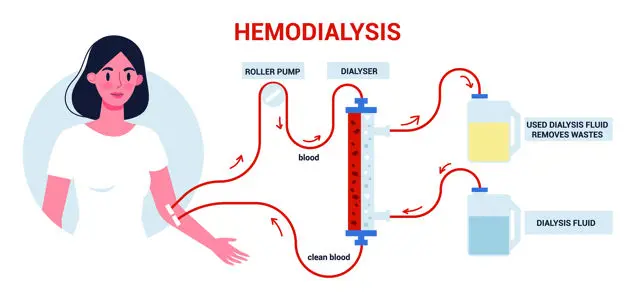19 Dec 2025
Age Specific Related to Psoriasis in Amritsar


Dr. Raka Kaushal
22 May 2025
Call +91 80788 80788 to request an appointment.
Chronic kidney disease (CKD) affects millions of people worldwide, leading to the necessity for renal replacement therapy, such as dialysis. Patients facing kidney failure often encounter the daunting decision of choosing between different dialysis options. At Livasa Hospitals, our nephrology specialists understand this crucial choice and are dedicated to providing comprehensive information on both hemodialysis and peritoneal dialysis. This blog aims to compare these two primary dialysis options, helping patients make informed decisions about their renal care.
According to statistics from regional health agencies, the demand for dialysis procedures in Punjab is on the rise, with thousands of patients requiring these essential treatments every year. By understanding the differences and benefits of each dialysis option, patients can better navigate their healthcare journey.
Hemodialysis is a treatment that filters waste from the blood using a dialysis machine. This process involves diverting blood from the body to an artificial kidney, or dialyzer, where it is cleaned before being returned. The procedure usually takes about three to five hours and is typically performed three times a week at a dialysis center or at home, depending on the patient's condition.
The hemodialysis process involves several key steps:
Hemodialysis offers various benefits, including the ability to effectively remove toxins and excess water from the body. However, it also has potential drawbacks such as the need for regular travel to a dialysis center, risk of infection at the access site, and potential dietary restrictions. Understanding these factors is essential for informed decision-making.
Peritoneal dialysis (PD) is a different form of dialysis that uses the peritoneal cavity in the abdomen as a natural filter. In this method, a sterile solution, called dialysate, is introduced into the peritoneal cavity through a catheter, where it absorbs waste products and excess fluids from the blood vessels in the lining of the abdominal cavity. After some time, the used dialysate is drained out and replaced with fresh dialysate.
There are different types of peritoneal dialysis, including:
Peritoneal dialysis allows for greater flexibility compared to hemodialysis. Patients can perform PD at home and have fewer dietary restrictions. However, it requires a commitment to daily routines and the risk of peritonitis, a potentially severe infection of the peritoneal cavity.
When considering dialysis options in Punjab, it is vital to compare the advantages and disadvantages of both hemodialysis and peritoneal dialysis. The following table summarizes the key aspects of each treatment method:
| Feature | Hemodialysis | Peritoneal Dialysis |
|---|---|---|
| Location | Dialysis center or home | Home |
| Frequency | 3 times per week | Daily |
| Time Requirement | 3-5 hours per session | 30 minutes to several hours per exchange |
| Dietary Restrictions | Yes | Fewer restrictions |
| Risk of Infection | Access site infections | Peritonitis |
The choice between hemodialysis and peritoneal dialysis is not merely a medical decision; it encompasses multiple patient-specific factors. Here are critical considerations to discuss with your nephrology specialist at Livasa Hospitals:
Discussing these factors with the nephrology specialists at Livasa Hospitals ensures a tailored approach to renal care in Punjab.
Financial considerations significantly influence the choice of dialysis. Both hemodialysis and peritoneal dialysis have associated costs, which can vary based on the facility, frequency of treatment, and additional medical needs. In Punjab, patients have expressed concerns regarding affordability and insurance coverage.
Typically, hemodialysis can be less expensive in terms of equipment and consumables compared to peritoneal dialysis. However, the overall costs can fluctuate based on travel, time off work, and the patient's health status.
Here’s a basic overview of the potential cost elements associated with each treatment:
Both hemodialysis and peritoneal dialysis have proven effective in managing kidney failure. Research shows that patients on either treatment can live for many years with proper monitoring and care.
Recent studies indicate that patient outcomes and survival rates can vary based on adherence to prescribed treatment protocols, regular medical check-ups, and lifestyle choices such as diet and exercise. Importantly, patient satisfaction with their chosen treatment can greatly affect their quality of life.
Here are some key findings regarding the long-term effects of dialysis:
Deciding between hemodialysis and peritoneal dialysis poses critical considerations for patients facing kidney failure. Both methods offer effective ways to manage renal health; however, they come with their unique benefits and challenges.
It’s vital for patients to consult with nephrology specialists at Livasa Hospitals to understand their options, weigh the pros and cons, and ultimately make an informed decision that aligns with their health needs, lifestyle, and preferences.
The journey through kidney treatment can be overwhelming, but with the right information and support from healthcare professionals, patients can take charge of their health. For more information about dialysis procedures at Livasa Hospitals, you can visit our appointment page to speak with our nephrology specialists.
Staying informed and making proactive choices about your treatment can significantly improve your quality of life. Contact us at Livasa Hospitals by calling +91 80788 80788 for expert nephrology care in Punjab.
+91 80788 80788
Livasa Healthcare Group Corporate Office,Phase-8, Industrial Area, Sector 73, Sahibzada Ajit Singh Nagar, Punjab 160071
livasacare@livasahospitals.in
| Mohali | +91-99888 23456 |
| Amritsar | +91-99887 49494 |
| Hoshiarpur | +91-99883 35353 |
| Nawanshahr | +91-75081 82337 |
| Khanna | +91-98888 05394 |